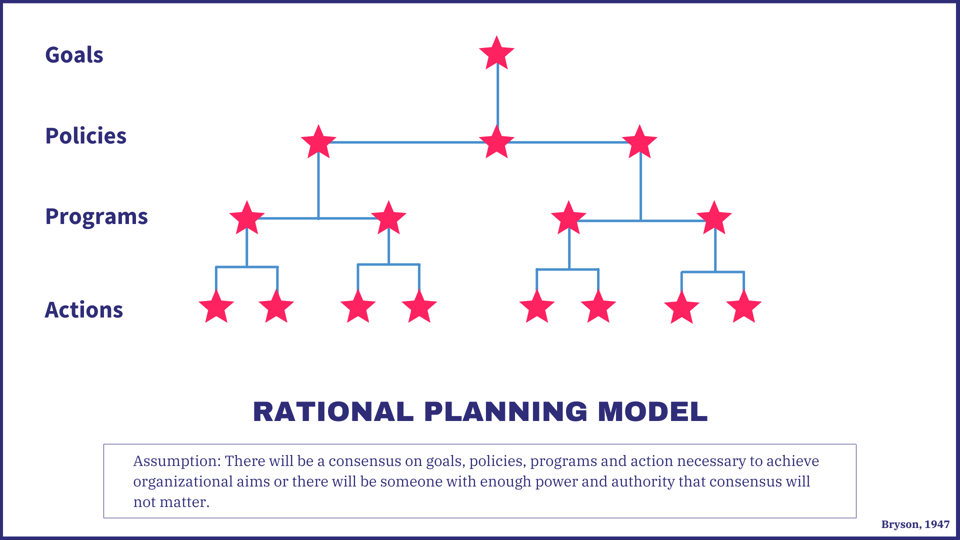Creating a Sales Plan
A sales plan is like a business plan in that it serves as a roadmap toward success, except a sales...

We’re constantly told the latest cloud technologies and software contain the secret sauce that will help you achieve your desired business outcomes. But that is not 100% true. Technology is a mere tool. A powerful tool, yes, but still a tool. And no tool should be the driving force of a project. Can you imagine a builder choosing what to build because they got a fancy new hammer? That hammer may make the job easier, but it is the blueprints that will ensure success. The success of any technology is only as good as your strategy which defines your plans, people, and processes.
This is where strategic planning (and MPWRSource!) come in.
Strategic planning will help you set your organizational priorities, focus your energy and resources, strengthen operations, and ensure that all stakeholders are working toward the same goal.

Successful strategic planning outlines actionable items that can be measured and defines an organization’s direction. It is a disciplined effort that can shape an organization and guide it by helping it fully flesh out its why, its market, what it does best, and focuses on the future.
A strategic planning is the process of documenting and establishing the direction of your business. It looks at both where you are currently and where you would like to go in the future. A strategic plan gives you a place to record your mission, vision, and values, as well as your long-term goals and action plans you’ll use to reach them.
A well-written strategic plan can play a large role in your business’s growth and overall success as it tells you and your employees how best to respond to both opportunities and challenges it may face.
While strategic planning includes defining an organization’s mission, vision, and values, those alone are not a strategic plan. A mission speaks to your what, your vision speaks to your why, and your values speak to your who. But your strategy takes all of those into account and speaks to your HOW. After all, it is all well and good to state that your organization values inclusion, but that value does not determine how inclusion will be implemented. When strategic planning aligns all your mission, vision, and values, you will have a clearer blueprint for the success of your company.

A good strategic plan will get your organization pointed in the right direction. The direction that aligns with your vision, mission, and goals. An effective strategic plan will help provide guidance on where your priorities should lie and where it is best to invest your time, money, talent, and energy. Oftentimes, many businesses will think that they simply don’t have the time to invest in strategic planning. But the truth is that is simply a rationalization. Developing a strategic plan, while yes, time consuming, actually saves time in the long run. And that is just one of its many benefits!
Strategic planning helps your business maintain a growth mindset. A growth mindset is one that believes that talents and growth can be developed, versus those things merely being innate. A growth mindset focuses on education, development, and growth. It values collaboration and innovation. It is the antidote to a team that is overly competitive and undercuts a corporate culture of fear. And fear is the enemy of growth and innovation. A strategic plan encourages a corporate culture of growth by setting a path to work towards and providing steps to take when innovation falls flat, ever reminding us that falling, so long as it is forward, is still growth.
A strategic plan, by providing a guiding path, makes decision making to be proactive rather than merely reactive. A strategic plan will highlight an organization’s overall mission so that business decisions can be tested to see if they support that goal. When faced with an opportunity, team members can think, “How does this align with my overall strategy? Will this get me to where I want to go?” And if not, then it’s a no. Furthermore, an effective strategy will also highlight some “what ifs” so that your organization is better apt to pivot and keep up with ever changing business markets and trends and staying ahead of the competition. Organizations that plan what they can control are better able to react positively to the things they cannot control.
A strategic plan helps to define the direction in which a business wants to go. It also helps to set realistic and measurable goals that are in line with the mission set before it. A strategic plan offers a much-needed foundation upon which all organizational activities can be built. It also helps you evaluate your success, pivot from missteps, compensate your employees adequately, and propel you forward with even better decision-making capabilities.
A strategic plan provides management with the blueprint to set operational activities to set and achieve goals. Because if it isn’t measured, how then will you be able to ascertain growth? A strategic plan enables effective goal setting of key performance indictors (KPIs). It also helps guide discussions on the allocation of resources and budgets.
Everyone benefits from having a clear idea of how their role plays in the “big picture”. An effective strategic growth plan helps each team member have a clearly defined role. This helps every team member, from the executive to the entry level employee, know what they’re supposed to be doing, how they’re going to achieve their goals, and also feel like a valued member of the team.
A strategic plan is a disciplined effort to produce fundamental decisions and actions that share and guide what an organization is, what it does, and why it does it. It helps create public value and is used to help organize manage effective organizational change processes in which the organization figures out what to change but also keeps the best.
A simple way of looking at strategic planning is to understand that it includes the concepts, procedures, and tools designed to help leaders, managers, and planners think, act, and learn strategically. Simply put, your strategic plan looks at where you are, where you want to be, and how to get there. It takes your mission, vision, and values and develops then into plans you can then implement to get you from here to there.
.png?width=960&name=The%20ABCs%20of%20Strategic%20Planning%20(2).png)
This is where you will want to identify the strategic issues facing your organization and ask some pointed questions.
A strategic business plan clearly defines the whats, whys, whos, wheres, whens, and hows of fulfilling objectives set forth in a business plan.
The main components of a strategic business plan are:
Your mission and vision will be the main focus of how to best fulfill your business objective. Your mission and vision will give direction to the business and drive the best path for what needs to be done, how it needs to be done, and just who is tasked with completing these objectives.
Your core values will stipulate a lot of how your business objectives are to be completed and will give further direction, from the top down, as to how to best achieve your goals.
SWOT stands for strengths, weaknesses, opportunities, and threat analysis. It is a rundown of your company’s current situation. It is a vital component of a business’ strategic plan because it points out what you are doing well and areas in which you have opportunities for growth.
Operational tactics are the portion of the strategic planning process whereby the large-scale strategy is broken down into specific steps in order to implement a company’s overall strategic plan. Operational tactics looks like: “If this is where we want to be in 5 years, what do we need to do in three years? What do we need to do next year? This year? This month?”
The resources portion of the strategic planning process looks at answer the where and how resources will be acquired and allotted in order to meet your goals and also sets who will be responsible for what part.
If there are no means of measuring your growth, you will not be able to adequately determine if your goals have been met by your strategy. By making sure that each of your goals is SMART (Specific, Measurable, Achievable, Realistic, and Time-bound), you will be able to ascertain how well you have met your strategic goals and where you still have opportunities to grow. It will also help you to determine how best to pivot by showing you your areas of success.

You may think that our world is changing at too fast of a pace for strategic planning to hold much relevancy. But that is exactly why strategic planning is vital. Without a plan as to how things should go, how your resources should be allocated, how team members will be kept held accountable, and which direction your business desires to go, you won’t be able to pivot successfully in a fast-paced market and you’ll be left behind by your better prepared competitors. So, the answer to this question is simple: EVERY BUSINESS NEEDS A STRATEGIC PLAN.
The strategic planning process can certainly take a while to accomplish, but done well, it is beneficial for everyone involved. Traditionally, strategic planning starts at the top of an organization, but should also consider key employees and clients who may have a good vantage point of how best to achieve an organization’s long-term goals.
It isn’t just Aaron Burr who wants to be in the room where it happens, but those with a vested interest in making sure the company’s vision, mission, and values are well represented in their strategic plan should be in the room where strategic planning takes place.
Executives in an organization, or a Board of Directors, play a vital role in determining an organization’s mission, vision, and values. They will help lay the foundation of what an organization’s principles should be and begin to set the path and determine the direction in which the organization wants to go. They will set strategic priorities and organization wide goals and key performance metrics. These goals should be updated at least every 5 years and reviewed by the executives annually.
There are parts of the strategic planning process that are truly all hands-on deck. Particularly the SWOT segment. Employees who are client-facing will be better able to get a lay of the land and better able to ascertain just where the organization is successful and meeting the needs of its market and where the organization needs to evolve. Managers and department heads can help create annual goals and KPIs, which support the organization-wide goals set by executives. These goals and KPIs should be established and reviewed annually. Team members who are involved in the day-to-day operations help drive your strategy from the ground up and can provide much-needed milestones that indicate whether you are headed in the proper direction.
You may think that your clients have no role to play in your strategic planning process. However, your market, and how well you are serving your market, can help you determine where you are missing the mark and where you are gaining traction. A failure to properly know your target market and their pain points can often lead to an organization’s failure.
As an organization sets about the strategic planning process, there are various approaches an organization can take to accomplish this task. The type of organization you have and the market you are serving will determine which model you deploy. A strategic planning model is how the organization takes its strategy and creates a plan of implementation to better meet their goals. Deploying a strategic planning model gives you the scaffolding you need to provide a clear path for everyone involved. At MPWRSource, we say that our plans have plans. And our strategies have models.
Our favorite planning model for small to mid-sized businesses is the Rational Planning Model. The Rational Planning model includes a comprehensive, long-range view and a systematic, analytical approach in a planning process. Due to its simplicity and logic, it is one of the most widely used planning models. The rational planning model is the process of realizing a problem, establishing, and evaluating planning criteria, creating alternatives, implementing alternatives, and monitoring the progress of said alternatives. It is central to transformation planning. It can help generate all possible solutions to problems and generate objective assessment criteria.

Because of their purpose of serving the community at large and their being led by a board of directors rather than the power being held in a more centralized fashion, nonprofits often use the Political Decision-Making model in order to construct a strategic plan. The Political Decision-Making Model works out consensual agreements on what programs and policies will best resolve key issues. It acknowledges the variety of personal interests and goals in a nonprofit organizational environment. Reaching a decision within the model requires resolving conflict, compromising, and building consensus with the other stakeholders in the organization as there is no one manager with centralized power.
.png?width=960&name=Goals%20Policies%20Programs%20Actions%20(1).png)
After you have collected all your information, such as your research and SWOT information, it is time to start to develop your strategic plan. This is when you remember that your strategic plan should include the key components: mission, vision, and business goals, core values, SWOT, Operational tactics, resources, and measurement information. Simply put, your strategic plan should include your vision and mission, your goals and objectives, an action plan on how to achieve said goals, and by what means you intend to measure the goals. It should also include how often you intend to review the plan and update it.
Your strategic planning team should identify practical alternatives and visions for resolving the issues discovered. Think action verbs here. You will be doing, getting, buying, achieving, etc. The team will also enumerate the barriers to achieving the set upon goals and visions. Then the team will develop proposals for achieving the organization’s dreams and visions. These proposed actions should be planned to be enacted over the next 2 to 3 years. And finally, a detailed tactical plan and work program for the next 6 to 12 months should be spelled out in order to implement the actions.
Strategic planning is an ongoing commitment. Even after research has been conducted and decisions have been made, the plan still must be implemented. One impediment to the success of a strategic plan is if the goals set forth within it are unrealistic. While surely every business owner desires growth, setting an overly ambitious growth rate can have a negative effect and discourage your employees. Further hindrances to a strategic plan’s success are if the strategic plan is not set forth as the foundation of a business. If it is not being regularly referenced or consulted by the executive team which formed it, chances are your employees will also lose sight of the organization’s overall direction, mission, vision, and goals.
Furthermore, a strategic plan requires consistent review. How often your strategic plan is updated is entirely dependent upon the nature of how your business works. Some fast-paced industries require quarterly reviews, while most businesses can be successful with an annual review of their strategic plan. When checking your strategic plan, check to see if the assumptions you made at your first pass are still correct. What has changed within the context your strategic plan was developed?
You want to make sure that the goals you set forth in your strategic plan are realistic and measurable. A goal of “growth” is too vague. A goal of increasing revenue by X% by X-time is measurable. If your action plan does not help your team achieve its goals, it needs to be rewritten. But that’s okay; you have a growth mindset now, remember?

A sales plan is like a business plan in that it serves as a roadmap toward success, except a sales...

Once you have your strategy, plan, and people in place, how are you going to do it? We’ve addressed...